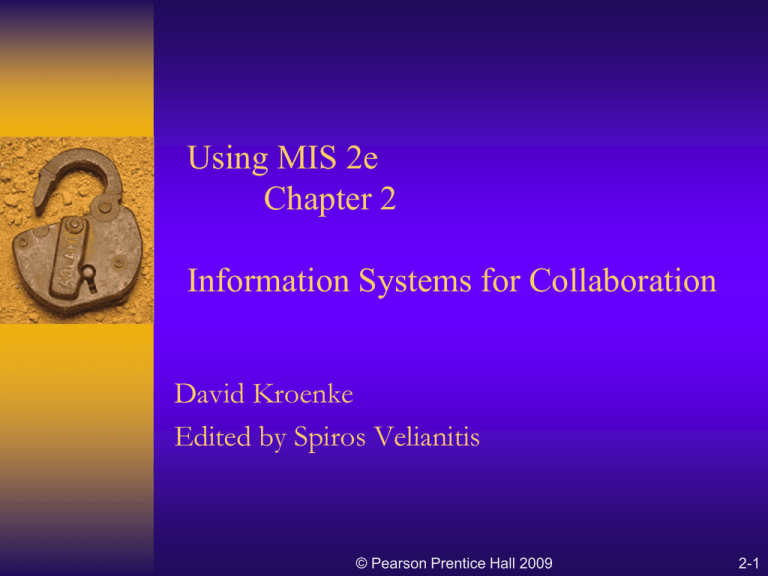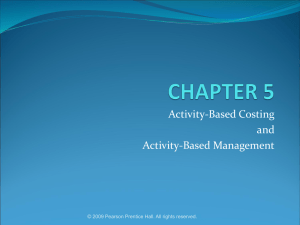
Using MIS 2e
Chapter 2
Information Systems for Collaboration
David Kroenke
Edited by Spiros Velianitis
© Pearson Prentice Hall 2009
2-1
Study Questions
Q1 – What is collaboration?
Q2 – How can you use collaboration systems to improve team
communication?
Q3 – How can you use collaboration systems to manage content?
Q4 – How can you use collaboration systems to control workflow?
Q5 – How do businesses use collaboration systems for decision
making?
Q6 – How do businesses use collaboration systems for problem
solving?
Q7 – How do businesses use collaboration systems for project
management?
© Pearson Prentice Hall 2009
2-2
Q1 – What is collaboration?
Q2 – How can you use collaboration systems to improve team
communication?
Q3 – How can you use collaboration systems to manage content?
Q4 – How can you use collaboration systems to control workflow?
Q5 – How do businesses use collaboration systems for decision
making?
Q6 – How do businesses use collaboration systems for problem
solving?
Q7 – How do businesses use collaboration systems for project
management?
© Pearson Prentice Hall 2009
2-3
Q1 – What is collaboration?
Collaboration occurs when two or more people work
together to achieve a common
– Goal
– Result
– Work product
Greater than individuals working alone
Involves more than coordination and communication alone
Feedback and iteration provide an opportunity for team
members to:
– Proceed in a series of steps (iterations) by continuously reviewing
and revising each other’s work
– Learn from each other rather than working in isolation
– Change the way they work and what they produce
– Ultimately produce a product that’s greater (and better) than an
individual could accomplish working alone
© Pearson Prentice Hall 2009
2-4
Q1 – What is collaboration?
The three critical collaboration drivers are:
– Communication
• The success of the collaboration group depends on the
availability of effective communication systems that allow
them to share their skills and abilities
– Content management
• Users need to manage the content of their work to avoid
conflicting with other team members.
– Workflow control
• Workflow is a process or procedure to create, edit, use, and
dispose of content.
© Pearson Prentice Hall 2009
2-5
Q1 – What is collaboration?
Q2 – How can you use collaboration
systems to improve team communication?
Q3 – How can you use collaboration systems to manage content?
Q4 – How can you use collaboration systems to control workflow?
Q5 – How do businesses use collaboration systems for decision
making?
Q6 – How do businesses use collaboration systems for problem
solving?
Q7 – How do businesses use collaboration systems for project
management?
© Pearson Prentice Hall 2009
2-6
Q2 – How can you use collaboration systems
to improve team communication?
Synchronous communication
– Team members meet at the same time, but not necessarily at
the same geographic location.
– It may include conference calls, face-to-face-meetings, or
online meetings.
Asynchronous communication
– Team members do not meet at the same time or in the same
geographic location.
– It may include discussion forums or email exchanges.
© Pearson Prentice Hall 2009
2-7
Q2 – How can you use collaboration systems
to improve team communication?
Fig 2-1 Information Technology for Communication
© Pearson Prentice Hall 2009
2-8
Q2 – How can you use collaboration systems
to improve team communication?
Virtual meetings don’t require everyone to be in the same place at
the same time.
– Conference calls – can be difficult to arrange the right time
– Multiparty text chat – easier to arrange if everyone has mobile texting
– Videoconferencing – requires everyone to have the proper equipment
– Email – most familiar but has serious drawbacks in content
management
– Discussion forums – content is more organized than email
– Team surveys – easy to manage but don’t provide very much
interactive discussion
© Pearson Prentice Hall 2009
2-9
Q1 – What is collaboration?
Q2 – How can you use collaboration systems to improve team
communication?
Q3 – How can you use collaboration systems
to manage content?
Q4 – How can you use collaboration systems to control workflow?
Q5 – How do businesses use collaboration systems for decision
making?
Q6 – How do businesses use collaboration systems for problem
solving?
Q7 – How do businesses use collaboration systems for project
management?
© Pearson Prentice Hall 2009
2-10
Q3 – How can you use collaboration systems
to manage content?
There are three categories for sharing content.
Your choice depends on the degree of control your
team needs to complete their tasks
Fig 2-5 Information Technology for Sharing Content
© Pearson Prentice Hall 2009
2-11
Q3 – How can you use collaboration systems
to manage content?
The following methods of sharing are effective but
provide no control over content management.
– Email attachments are the most primitive but have numerous
problems.
• Someone may not receive the email or ignores it.
• It’s difficult to manage attachments.
– A shared file server provides a single storage location for all
team members.
• It uses FTP technology to access files.
• Problems can occur if multiple team members
try using the same file at the same time.
© Pearson Prentice Hall 2009
2-12
Q3 – How can you use collaboration systems
to manage content?
These methods of content sharing provide version
management
– Wikis
– Google Docs and Spreadsheets
– Microsoft Office Groove
© Pearson Prentice Hall 2009
2-13
Q3 – How can you use collaboration systems
to manage content?
Wikis are shared knowledge bases, repositories of team
knowledge, which have or use tracking mechanisms for
changes.
Most commonly known wiki is wikipedia.com.
© Pearson Prentice Hall 2009
2-14
Q3 – How can you use collaboration systems
to manage content?
Google Docs and Spreadsheets
– Access it at http://docs.google.com with a Google account
(different from a Gmail account).
– Documents are stored on Google servers making them
accessible from anywhere.
– Team members can track revisions and review change
summaries.
– It’s a free service but you must use Google programs for
processing.
© Pearson Prentice Hall 2009
2-15
Q3 – How can you use collaboration systems
to manage content?
Microsoft Office Groove
– You create a workspace and invite others to join.
– Document changes are automatically provided to all team members.
– You can use VoIP rather than separate phone lines for
conversations.
– You can use it asynchronously or synchronously.
– You can use any computer or server to access workspaces.
– Each user must purchase a license and install it on each computer
(may be exceptions).
© Pearson Prentice Hall 2009
2-16
Q3 – How can you use collaboration systems
to manage content?
Shared content with version control provides more limitations than
version management and more control over changes to documents.
– It uses shared libraries (directories) to store documents.
– Users are given permissions that limit what they can do with
the documents.
– It requires users to check out documents and check them back
in.
– Microsoft SharePoint is the most popular for business use.
• It requires a publicly accessible server.
• It’s difficult to install.
© Pearson Prentice Hall 2009
2-17
Q1 – What is collaboration?
Q2 – How can you use collaboration systems to improve team
communication?
Q3 – How can you use collaboration systems to manage content?
Q4 – How can you use collaboration systems
to control workflow?
Q5 – How do businesses use collaboration systems for decision
making?
Q6 – How do businesses use collaboration systems for problem
solving?
Q7 – How do businesses use collaboration systems for project
management?
© Pearson Prentice Hall 2009
2-18
Q4 – How can you use collaboration systems
to control workflow?
Sequential workflow
– When documents are reviewed by multiple members of a team one
after another
Parallel workflow
– When documents are reviewed by multiple members of a team
simultaneously
SharePoint site
– Defines workflows and ensures team members perform required
tasks (http://sharepoint.microsoft.com/enus/Pages/Videos.aspx?VideoID=1 )
© Pearson Prentice Hall 2009
2-19
Q1 – What is collaboration?
Q2 – How can you use collaboration systems to improve team
communication?
Q3 – How can you use collaboration systems to manage content?
Q4 – How can you use collaboration systems to control workflow?
Q5 – How do businesses use collaboration
systems for decision making?
Q6 – How do businesses use collaboration systems for problem
solving?
Q7 – How do businesses use collaboration systems for project
management?
© Pearson Prentice Hall 2009
2-20
Information Systems for Decision Making
Decision making in organizations is varied and complex.
Decisions occur at three levels in organizations (decision
levels):
Operational decisions concern day-to-day activities.
– Information systems that support operational decision making are
called transaction processing systems (TPS).
Managerial decisions concern the allocation and utilization
of resources.
– Information systems that support managerial decision making are
called management information systems (MIS).
Strategic decision making concern broader-scope
organizational issues.
– Information systems that support strategic decision making are
called executive information systems (EIS).
Information Systems for Problem Solving
Information systems can be used to solve problems.
Problem definition
– A problem is a perceived difference between what is and what is
not.
– A problem is a perception.
– A good problem definition defines the differences between what is
and what ought to be by describing both the current and desired
situations.
– Different problem definitions require the development of different
information systems.
– All personnel in the organization must have a clear understanding
of which definition of the problem the information system will
address.
Decision Making and Problem Solving
Problem solving is the most critical activity a business organization
undertakes. Problem solving begins with decision making.
In the intelligence stage, potential problems and /or opportunities are
identified and defined
In the design stage, alternative solutions to the problem are developed
In the choice stage, a course of action is selected
In the implementation stage, action is taken to put the solution into
effect
In the monitoring stage, the implementation of the solution is evaluated
to determine if the anticipated results were achieved and modify the
process
The Decision Process
Two decision processes (method by which a decision is to
be made) are structured and unstructured.
Structured decision process is one for which there is an
understood and accepted method for making the decision.
Unstructured process is one for which there is no agreed on
decision making process.
The terms structured and unstructured refers to the decision
process-not the underlying subject.
Q5 – How do businesses use collaboration systems
for decision making?
Fig 2-15 Collaboration Needs for Decision Types
© Pearson Prentice Hall 2009
2-25
Optimization, Satisficing, and Heuristic
Optimizing is finding the best solution and is usually best
fit for problems that can be modeled mathematically with a
low degree of estimation risk. For example, find how many
products an organization should produce to meet a profit
goal.
Satisficing is finding a good, but not necessarily the best,
solution. Satisficing does not look at all possible solutions,
but at those that are likely to give good results. Satisficing
is a good decision method because it is sometimes too
expensive to analyze every alternative to get the best
solution. A satisficing example is when you have to select a
location for a new plant.
Heuristics are guidelines or procedures that usually find a
good solution by using “rules of thumb”.
Different Types of Information Systems for
Different Types of Decisions
Automated information systems are those by which the
computer hardware and program components do most of
the work.
– Humans start the programs and use the results.
Augmentation information systems are those in which
humans do the bulk of the work.
– These systems augment, support, or supplement the work done by
People (email, instant messaging, video-conferencing, etc) to aid in
decision making.
Q1 – What is collaboration?
Q2 – How can you use collaboration systems to improve team
communication?
Q3 – How can you use collaboration systems to manage content?
Q4 – How can you use collaboration systems to control workflow?
Q5 – How do businesses use collaboration systems for decision
making?
Q6 – How do businesses use collaboration
systems for problem solving?
Q7 – How do businesses use collaboration systems for project
management?
© Pearson Prentice Hall 2009
2-28
Q6 – How do businesses use collaboration systems
for problem solving?
Collaboration systems provide team members with
feedback and iteration that helps them:
– Identify numerous solution alternatives rather than just
one.
– Make a choice by allowing them to discuss the pros and
cons of each alternative.
– Broker the selected solution and make necessary
adjustments that benefit all parties.
© Pearson Prentice Hall 2009
2-29
Q6 – How do businesses use collaboration systems
for problem solving?
Problem solving and collaboration systems are more
effective when they successfully employ the three
collaborative drivers:
– Communication systems that allow a regular and reliable
exchange of ideas and information
– Content-management systems that control document changes
and revisions so everyone has the most current version
– Workflow control is less important because of the nature of the
unstructured decision-making process
© Pearson Prentice Hall 2009
2-30
Q1 – What is collaboration?
Q2 – How can you use collaboration systems to improve team
communication?
Q3 – How can you use collaboration systems to manage content?
Q4 – How can you use collaboration systems to control workflow?
Q5 – How do businesses use collaboration systems for decision
making?
Q6 – How do businesses use collaboration systems for problem
solving?
Q7 – How do businesses use collaboration
systems for project management?
© Pearson Prentice Hall 2009
2-31
Q7 – How do businesses use collaboration systems
for project management?
The three collaborative drivers are important to ensure the
success of a project.
– Communication systems help decision makers communicate with
one another and deal with unexpected problems as they occur.
– Content-management systems control document changes and
revisions that occur during the project.
– Workflow control is important because of task dependencies
inherent in projects.
© Pearson Prentice Hall 2009
2-32
Q7 – How do businesses use collaboration systems for project
management?
Fig 2-17 Collaboration Systems for Decision Making, Problem Solving & Project
Mgt
© Pearson Prentice Hall 2009
2-33





